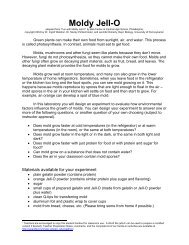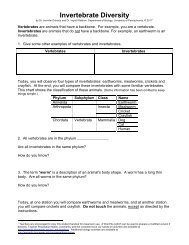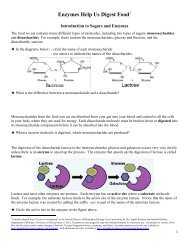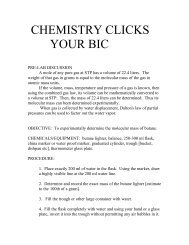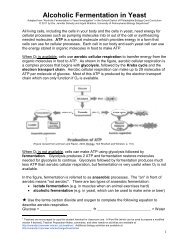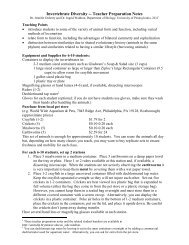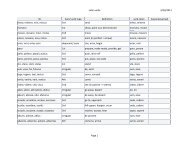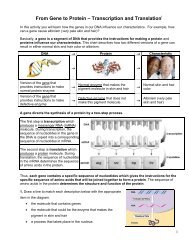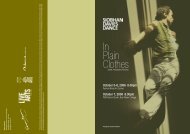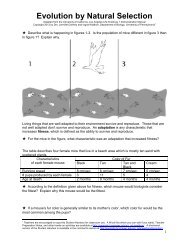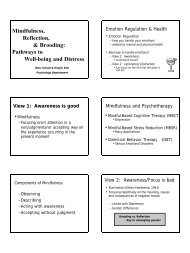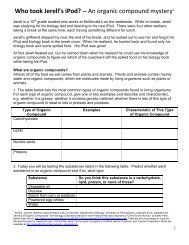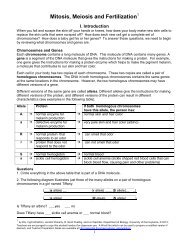Mitosis, Meiosis and Fertilization -- Teacher Preparation ... - Serendip
Mitosis, Meiosis and Fertilization -- Teacher Preparation ... - Serendip
Mitosis, Meiosis and Fertilization -- Teacher Preparation ... - Serendip
Create successful ePaper yourself
Turn your PDF publications into a flip-book with our unique Google optimized e-Paper software.
<strong>Mitosis</strong>, <strong>Meiosis</strong> <strong>and</strong> <strong>Fertilization</strong> -- <strong>Teacher</strong> <strong>Preparation</strong> Notes<br />
By Drs. Ingrid Waldron, Jennifer Doherty, Scott Poethig <strong>and</strong> Lori Spindler,. Department of Biology, University of Pennsylvania, 2012 1<br />
In this activity, students use model chromosomes to simulate the processes of mitosis, meiosis<br />
<strong>and</strong> fertilization <strong>and</strong> they answer questions designed to promote student underst<strong>and</strong>ing of these<br />
processes. The principle that genes are inherited through the processes of meiosis <strong>and</strong><br />
fertilization is demonstrated by analysis of a simulation of meiosis <strong>and</strong> fertilization using model<br />
chromosomes with different alleles of a gene. Students also learn how a mistake in meiosis can<br />
result in Down Syndrome.<br />
Teaching Points<br />
• Each chromosome has a DNA molecule which contains many genes.<br />
• Each human cell has 46 chromosomes = 23 pairs of homologous chromosomes. 2 For each<br />
pair of homologous chromosomes, both chromosomes contain the same genes which code for<br />
the same proteins <strong>and</strong> influence the same characteristics. However, the two homologous<br />
chromosomes may have different versions of a gene; e.g. the allele on one chromosome may<br />
code for a normal enzyme <strong>and</strong> the allele on the other homologous chromosome may code for<br />
a defective version of the enzyme).<br />
• There are two types of cell division, mitosis <strong>and</strong> meiosis. Cells are produced by mitosis<br />
(almost all cells), meiosis (sperm <strong>and</strong> eggs), or fertilization (zygote).<br />
• Some similarities between mitosis <strong>and</strong> meiosis are:<br />
o Before mitosis or meiosis, the DNA is replicated to form two copies of the original<br />
DNA.<br />
o At the beginning of mitosis or meiosis, the replicated DNA is condensed into sister<br />
chromatids in each chromosome.<br />
o At the end of each cell division, cytokinesis forms two daughter cells.<br />
• The purpose of mitosis is to produce new cells for growth, development <strong>and</strong> repair.<br />
• <strong>Mitosis</strong> separates sister chromatids complete sets of chromosomes at opposite ends of cell,<br />
so each daughter cell receives a complete set of chromosomes with exactly the same genes as<br />
the original cell.<br />
• The purpose of meiosis is to produce haploid eggs <strong>and</strong> sperm (23 chromosomes in humans),<br />
so fertilization can produce a diploid zygote (fertilized egg with 46 chromosomes in<br />
humans).<br />
• <strong>Meiosis</strong> consists of two cell divisions. <strong>Meiosis</strong> I separates pairs of homologous<br />
chromosomes <strong>and</strong> <strong>Meiosis</strong> II separates sister chromatids 23 chromosomes in each egg or<br />
sperm.<br />
• Different eggs or sperm from the same person have different genetic makeup.<br />
• When a sperm fertilizes an egg, the resulting zygote receives one copy of each gene from the<br />
mother <strong>and</strong> one from the father. Thus, each person receives half of his/her genes from<br />
his/her mother <strong>and</strong> half from his/her father.<br />
• Underst<strong>and</strong>ing genes, chromosomes, meiosis <strong>and</strong> fertilization provides the basis for<br />
underst<strong>and</strong>ing inheritance. 3<br />
1 These <strong>Teacher</strong> <strong>Preparation</strong> Notes, the related student h<strong>and</strong>out, <strong>and</strong> additional h<strong>and</strong>s-on, minds-on biology activities are<br />
available at http://serendip.brynmawr.edu/sci_edu/waldron .<br />
2 There are a few exceptions (e.g. gametes <strong>and</strong> red blood cells). Chromosome number differs for different organisms <strong>and</strong> there<br />
are some other differences between organisms in specific aspects of these processes, but the basic processes are similar in all<br />
eukaryotes.<br />
3 This idea is developed further in the activity, "Genetics", available at http://serendip.brynmawr.edu/sci_edu/waldron/#genetics.<br />
1
• If there is a mistake in meiosis <strong>and</strong> the zygote does not receive exactly the correct number of<br />
chromosomes, this results in abnormalities such as Down Syndrome or, more frequently,<br />
death of the embryo.<br />
Instructional Suggestions<br />
Before beginning this activity students should know what a cell is <strong>and</strong> underst<strong>and</strong> basic<br />
information about the functions of DNA <strong>and</strong> proteins; see e.g. the learning activities in<br />
"Underst<strong>and</strong>ing the Functions of Proteins <strong>and</strong> DNA" (available at<br />
http://serendip.brynmawr.edu/exchange/bioactivities/).<br />
This "<strong>Mitosis</strong>, <strong>Meiosis</strong> <strong>and</strong> <strong>Fertilization</strong>" activity can be presented in two 50-minute class<br />
periods, or you may want to use the exp<strong>and</strong>ed learning sequence provided in "<strong>Mitosis</strong>, <strong>Meiosis</strong><br />
<strong>and</strong> <strong>Fertilization</strong> -- Concepts <strong>and</strong> Learning Activities" (available at<br />
http://serendip.brynmawr.edu/exchange/bioactivities/).<br />
We recommend using the first 50-minute class period to cover the introductory review of<br />
chromosomes <strong>and</strong> genes (pages 1-2 in the Student H<strong>and</strong>out) <strong>and</strong> the section on mitosis (pages 2-<br />
5, with an additional question on the top of page 6). After completing the introduction to mitosis<br />
(pages 2-4) <strong>and</strong> before beginning the mitosis modeling activity (page 5), we recommend showing<br />
two short videos available at http://iknow.net/cell_div_education.html. Specifically, we<br />
recommend that you first show "Plant Cell <strong>Mitosis</strong>" which has clear diagrams <strong>and</strong> then show<br />
"Live Animal <strong>Mitosis</strong>" which has good video of an actual cell undergoing mitosis with helpful<br />
explanations. These videos also demonstrate cytokinesis <strong>and</strong> how this differs between plant <strong>and</strong><br />
animal cells.<br />
We recommend using the second 50-minute class period for meiosis <strong>and</strong> fertilization (pages 6-<br />
11). During your discussion of questions 5 <strong>and</strong> 6 on pages 8-9 concerning the differences <strong>and</strong><br />
similarities between mitosis <strong>and</strong> meiosis, you may want your students to view the animation<br />
comparing mitosis <strong>and</strong> meiosis available at http://www.pbs.org/wgbh/nova/baby/divide.html#.<br />
Instructions for making the model chromosomes for this activity are provided on pages 3-6 of<br />
these <strong>Teacher</strong> <strong>Preparation</strong> Notes. The simulations of mitosis, meiosis <strong>and</strong> fertilization should be<br />
done on a lab table or similar large flat surface, so students can more easily see the processes <strong>and</strong><br />
outcomes. If students have difficulty recognizing which chromosomes are in the different cells<br />
at the end of mitosis or meiosis I or II, you may want to provide pieces of string or yarn for<br />
students to use as cell membranes.<br />
To prevent student confusion, remind students to check the figures on page 3 <strong>and</strong> page 7 of the<br />
Student H<strong>and</strong>out as they model mitosis <strong>and</strong> meiosis, respectively. Also, in our experience, it is<br />
crucial to circulate among student groups continuously <strong>and</strong> provide considerable input.<br />
We have focused our activity on underst<strong>and</strong>ing the processes of mitosis <strong>and</strong> meiosis <strong>and</strong> have<br />
limited technical terminology to the terms that are most important for underst<strong>and</strong>ing these<br />
processes. Students often have difficulty underst<strong>and</strong>ing the difference between chromosomes<br />
<strong>and</strong> chromatids, so we have made a special effort to clarify this distinction (e.g. on page 3 <strong>and</strong><br />
question 3 on page 4). If you want to incorporate additional terminology, you can revise the<br />
Word document for the Student H<strong>and</strong>out; for example, you can incorporate the names of the<br />
phases of mitosis in the questions on page 4.<br />
Many students have difficulty underst<strong>and</strong>ing <strong>and</strong> distinguishing the concepts of DNA, genes <strong>and</strong><br />
chromosomes. In this activity, almost all the student questions ask about the A/a <strong>and</strong> D/d<br />
alleles. We have included the R <strong>and</strong> S alleles on the model chromosomes with the A/a alleles to<br />
2
counteract the tendency for some students to assume that each chromosome has only a single<br />
gene. One analogy that may be helpful is to compare each gene to a recipe which gives<br />
instructions about how to combine the right components to make a protein (comparable to a<br />
recipe for a soup, salad or cake). Each chromosome has hundreds of these recipes for different<br />
proteins, so you could compare each chromosome to a chapter in a cookbook. All the<br />
chromosomes together are like a cookbook which provides recipes for all the different proteins<br />
our bodies need to make (or all the different dishes a person would want to cook). Different<br />
alleles of a gene produce different versions of the same protein, which is comparable to different<br />
versions of a recipe (e.g. brownie recipes with different numbers of eggs produce brownies with<br />
different textures). We think this analogy is useful, but you should be aware that the explanation<br />
of the effects of trisomy at the end of the protocol uses the analogy differently <strong>and</strong> treats the<br />
whole genome as one recipe.<br />
If you would like to have a key with the answers to the questions in the Student H<strong>and</strong>out, please<br />
send a message to iwaldron@sas.upenn.edu.<br />
Caution for Mac users: If you want to use the Word version of the Student H<strong>and</strong>out, please check<br />
that the diagrams display properly, as shown in the PDF version.<br />
Preparing the Model Chromosomes<br />
You will need 8 model chromosomes for each pair of student groups (2-4 students in each group)<br />
(see charts on pages 4 <strong>and</strong> 6). You can use sockosomes, chromonoodles or posterboard model<br />
chromosomes. The sockosomes provide three-dimensional models that look like metaphase<br />
chromosomes as shown in karyotypes, <strong>and</strong> sockosomes are small enough for easy classroom use<br />
<strong>and</strong> storage. Sockosomes are relatively time-consuming to make, although this can be a good<br />
time investment if you will be using the sockosomes year after year. The chromonoodles<br />
provide three-dimensional model chromosomes that are relatively easy to make, but they are<br />
relatively large, so each student group will need a relatively large surface to work on (>= 30" by<br />
30", e.g. a lab table or desks pushed together). The posterboard model chromosomes may be the<br />
easiest to make, but they are not durable <strong>and</strong> not as engaging for students.<br />
Sockosomes<br />
Supplies:<br />
--Small or medium children’s crew socks (no more than half of any one color; even number of<br />
pairs of each color sock; eight pairs of socks for two groups of 2-4 students each (see chart<br />
on page 4); avoid black <strong>and</strong> dark blue socks typically found in packs of boys socks). To<br />
make the two different chromosomes different sizes, turn the cuffs of half of them down<br />
inside to make half the sockosomes smaller<br />
-- Fiber fill<br />
-- Self-stick squares or circles of hook-<strong>and</strong>-loop fasteners (Velcro); if you are making more than<br />
36 sockosomes it may be more cost effective to purchase a roll of self-stick hook-<strong>and</strong>-loop tape<br />
<strong>and</strong> cut it into 1/2 “ pieces.<br />
-- Needle <strong>and</strong> thread<br />
-- 1” wide masking tape <strong>and</strong> permanent markers (e.g. Sharpies)<br />
Making the Sockosomes:<br />
1. Attach <strong>and</strong> secure with staples or by sewing one part of a piece of self-stick hook-<strong>and</strong>-loop<br />
tape (the fuzzy part) to the heel of one sock, <strong>and</strong> attach the other part (the part with hooks) to the<br />
heel of the other sock.<br />
2. Fill each sock with fiber fill, <strong>and</strong> sew the end of each sock closed (sewing works much better<br />
than gluing for this step). This is the step at which you make half of each color shorter by folding<br />
the cuff down inside of the sock before stuffing.<br />
3
3. Stick the socks together at the heels. You now have a chromosome with two chromatids,<br />
where each sock represents a chromatid. Note that a sockosome refers to the pair of socks<br />
attached by hook-<strong>and</strong>-loop tape, not the individual socks.<br />
4. Each pair of homologous chromosomes will be represented by two sockosomes of the same<br />
size <strong>and</strong> color, one with a stripe marked along the length of each sock with a permanent marker<br />
(representing the potentially different alleles on the two homologous chromosomes). Your<br />
students will work in groups of 2-4. For each pair of student groups, you will need eight<br />
sockosomes (see instructions 5 <strong>and</strong> 6 <strong>and</strong> the chart below).<br />
S R<br />
a<br />
5. To prepare the sockosomes shown on the left, get two pairs of homologous sockosomes; as<br />
shown in the chart below, all these sockosomes should be the same size, <strong>and</strong> one pair of<br />
homologous sockosomes should be one color <strong>and</strong> the other pair should be a different color.<br />
(Since the S, R, <strong>and</strong> A genes are on human chromosome 11, <strong>and</strong> the D gene is on the shorter<br />
chromosome 4, if you have sockosomes of different sizes use shorter sockosomes for this step<br />
<strong>and</strong> longer sockosomes for step 6.) Add a ring of tape around each sock in each sockosome to<br />
represent an allele of each of the genes, as shown in the figure above. The tape stays on best if it<br />
goes completely around the sock, overlapping at the ends. Write in the alleles for skin<br />
pigmentation (A for pigmented skin or a for the albino allele) plus the R <strong>and</strong> S alleles (for<br />
normal hemoglobin <strong>and</strong> normal smell receptor protein). Obviously, for each gene the allele<br />
labeled on both socks in a single sockosome should be the same. Draw a stripe on each<br />
chromatid of one sockosome from each pair of homologous sockosomes.<br />
6. Get another two pairs of homologous sockosomes (both the same size, but different colors; see<br />
the chart below). Label them with the alleles for dwarfism versus normal height (D or d).<br />
Eight Sockosomes Needed for Two Groups of 2-4 Students Each<br />
<strong>Mitosis</strong> &<br />
Meoisis<br />
Activities --<br />
Group 1<br />
<strong>Mitosis</strong> &<br />
Meoisis<br />
Activities --<br />
Group 2<br />
a (<strong>and</strong> R, S)<br />
sockosome in<br />
solid color 1<br />
d sockosome in<br />
solid color 3*<br />
S<br />
R<br />
A<br />
A (<strong>and</strong> R, S)<br />
sockosome in<br />
solid color 1 but<br />
with a stripe<br />
D sockosome in<br />
solid color 3*<br />
but with a stripe<br />
d D<br />
d sockosome in<br />
solid color 2<br />
a (<strong>and</strong> R, S)<br />
sockosome in<br />
solid color 4*<br />
D sockosome in<br />
solid color 2 but<br />
with a stripe<br />
A (<strong>and</strong> R, S)<br />
sockosome in<br />
solid color 4*<br />
but with a stripe<br />
*Solid color 3 can be the same as solid color 1, <strong>and</strong> solid color 4 can be the same as solid<br />
color 2. The specific colors used can vary for different sets of sockosomes.<br />
These same sockosomes can be used for these two groups of students to model meiosis followed<br />
by fertilization (in the activity on pages 9-10 of the Student H<strong>and</strong>out), but for this activity one<br />
4
group should have all the a <strong>and</strong> A sockosomes, <strong>and</strong> the other group should have all the d <strong>and</strong> D<br />
sockosomes. The pair of sockosomes in one color will represent the mother's chromosomes, <strong>and</strong><br />
the pair of sockosomes in the other color will represent the father's chromosomes. The different<br />
colors for the mother’s <strong>and</strong> father's sockosomes represent the fact that, although the labeled<br />
alleles are the same for the mother’s <strong>and</strong> father’s chromosomes, there are many genes on each<br />
chromosome <strong>and</strong> the mother’s <strong>and</strong> father’s chromosomes will have different alleles for many of<br />
these genes.<br />
Chromonoodles (adapted from "Chromonoodles: Jump into the Gene Pool" by Farrar <strong>and</strong><br />
Barnhart, The Science <strong>Teacher</strong>, Summer 2011, 78:34-39)<br />
Supplies:<br />
For two groups of 2-4 students each:<br />
-- 2 swim noodles (the smallest diameter available), two different colors (you will need<br />
52" of each color)<br />
Note: You may need to purchase these swim noodles during the summer.<br />
-- 8” self-stick hook-<strong>and</strong>-loop tape (Velcro), cut into 1“ pieces.<br />
-- 1” wide masking tape<br />
-- permanent marker (e.g. Sharpy)<br />
Making the Chromonoodles:<br />
To make 8 chromonoodles for two groups of 2-4 students each:<br />
1. Cut each swim noodle into eight pieces, four that are 8" long <strong>and</strong> four that are 5" (using a<br />
utility or serrated kitchen knife or a b<strong>and</strong> saw). For each pair of pieces that are the same<br />
color <strong>and</strong> length, stick opposite sides of the hook-<strong>and</strong>-loop tape on the pieces of swim noodle<br />
(about one-third of the way from one end), so the two pieces of swim noodle can be attached<br />
as sister chromatids. You now have eight model chromosomes, each with two chromatids,<br />
where each piece of swim noodle represents a chromatid.<br />
Note: A chromonoodle him of swim noodle pieces attached by hook-<strong>and</strong>-loop tape, not the<br />
individual pieces.<br />
2. Pairs of homologous chromosomes are represented by two chromonoodles of the same color<br />
<strong>and</strong> length. For each pair of homologous chromosomes, use a permanent marker to make<br />
long stripes down both chromatids of one of these chromosomes; these stripes will represent<br />
the differences in alleles from the other homologous chromosome.<br />
3. Add a ring of tape around each noodle piece in each chromonoodle to represent an allele of<br />
each of the genes as shown in the figure below; the tape stays on best if it goes completely<br />
around the noodle, overlapping at the ends. Use the instructions below <strong>and</strong> on the next page<br />
to label the alleles.<br />
8" Chromonoodles 5" Chromonoodles<br />
_______________________________ _________________<br />
(___|S | ____|R | __________|a |__ _) (__________|d |__ _)<br />
__________________*_____________ _______*_________<br />
(___|S | ____|R | __________|a |__ _) (__________|d |__ _)<br />
_______________________________ _________________<br />
(___|S | ____|R | __________|A |__ _) (__________|D |__ _)<br />
__________________*_____________ _______*_________<br />
(___|S | ____|R | __________|A |__ _) (__________|D |__ _)<br />
Each * represents a hook-<strong>and</strong>-loop tape attachment in the centromere region.<br />
Your students will work in groups of 2-4; for each pair of student groups, you will need eight<br />
chromonoodles (see the chart below). Get four 8" chromonoodles (one striped <strong>and</strong> one unstriped<br />
5
for color 1 <strong>and</strong> one striped <strong>and</strong> one unstriped for color 2) <strong>and</strong> use the figure on the previous page<br />
<strong>and</strong> the chart below to label them with the alleles for skin pigmentation (A for pigmented skin or<br />
a for the albino allele) plus the R <strong>and</strong> S alleles (for normal hemoglobin <strong>and</strong> normal smell<br />
receptor protein). Then, get four of the 5" chromonoodles <strong>and</strong> use the chart below to label them<br />
with the alleles for dwarfism versus normal height (D <strong>and</strong> d). (Note: The relative lengths of the<br />
chromonoodles are a matter of practical convenience <strong>and</strong> do not reflect the actual relative lengths<br />
of the shorter human chromosome 11 which has the A, R, <strong>and</strong> S genes <strong>and</strong> the longer<br />
chromosome 4 which has the D gene.)<br />
Eight Chromonoodles Needed for Two Groups of 2-4 Students Each (The chromonoodles<br />
will not have the shapes shown here but will look more like the figure on the previous page.)<br />
<strong>Mitosis</strong> &<br />
Meoisis<br />
Activities --<br />
Group 1<br />
<strong>Mitosis</strong> &<br />
Meoisis<br />
Activities --<br />
Group 2<br />
a (<strong>and</strong> R, S)<br />
chromonoodle in<br />
solid color 1<br />
d chromonoodle<br />
in solid color 1<br />
A (<strong>and</strong> R, S)<br />
chromonoodle in<br />
solid color 1 but<br />
with a stripe<br />
D chromonoodle<br />
in solid color 1<br />
but with a stripe<br />
d chromonoodle<br />
in solid color 2<br />
a (<strong>and</strong> R, S)<br />
chromonoodle in<br />
solid color 2<br />
D chromonoodle<br />
in solid color 2<br />
but with a stripe<br />
A (<strong>and</strong> R, S)<br />
chromonoodle in<br />
solid color 2 but<br />
with a stripe<br />
These same chromonoodles can be used for these two groups of students to model meiosis<br />
followed by fertilization (in the activity on pages 9-10 of the Student H<strong>and</strong>out), but for this<br />
activity one group should have all the a <strong>and</strong> A chromonoodles, <strong>and</strong> the other group should have<br />
all the d <strong>and</strong> D chromonoodles. The pair of chromonoodles in one color will represent the<br />
mother's chromosomes, <strong>and</strong> the pair of chromonoodles in the other color will represent the<br />
father's chromosomes. The different colors for the mother’s <strong>and</strong> father's chromonoodles<br />
represent the fact that, although the labeled alleles are the same for the mother’s <strong>and</strong> father’s<br />
chromosomes, there are many genes on each chromosome <strong>and</strong> the mother’s <strong>and</strong> father’s<br />
chromosomes will have different alleles for many of these genes.<br />
Posterboard models: If you do not have the time <strong>and</strong>/or budget to prepare sockosomes or<br />
chromonoodles, you can use posterboard models of the chromosomes made from posterboard or<br />
card stock available from stationery stores. You can use the pattern on the last page of these<br />
<strong>Teacher</strong> <strong>Preparation</strong> Notes to cut out individual chromatids. To attach the sister chromatids, put<br />
poster tack on top of the centromere of one sister chromatid <strong>and</strong> then press the centromere of the<br />
other sister chromatid onto the poster tack. Use the chart <strong>and</strong> instructions for sockosomes on<br />
page 4 to make the right number <strong>and</strong> colors of model chromosomes for the activities.<br />
6
Biology Background <strong>and</strong> Supplementary Information<br />
The rate of cell replacement by mitosis varies for different circumstances <strong>and</strong> different types of<br />
cells. The rate of cell division <strong>and</strong> replacement is greater when an injury has occurred. Cells that<br />
are routinely exposed to injury (e.g. skin cells or epithelial cells that line the lumen of the<br />
stomach <strong>and</strong> small intestine) are replaced within days or a couple of weeks. In contrast, nerve<br />
cells <strong>and</strong> muscle cells can last a lifetime. Mammalian red blood cells are a special case since<br />
they have no nucleus or mitochondria (which maximizes the amount of hemoglobin <strong>and</strong> thus<br />
oxygen that each red blood cell transports); this is the primary reason that red blood cells only<br />
survive about four months. New red blood cells are produced by mitosis <strong>and</strong> differentiation of<br />
stem cells in the red bone marrow.<br />
Additional information on sickle cell anemia, albinism <strong>and</strong> achondroplasia is provided in the<br />
<strong>Teacher</strong> <strong>Preparation</strong> Notes for our "Genetics" activity (available at<br />
http://serendip.brynmawr.edu/sci_edu/waldron/) <strong>and</strong> in "Underst<strong>and</strong>ing the Functions of Proteins<br />
<strong>and</strong> DNA" (available at http://serendip.brynmawr.edu/exchange/bioactivities). For additional<br />
information on the inherited conditions discussed in this activity, search OMIM (Online<br />
Mendelian Inheritance in Man, http://www.ncbi.nlm.nih.gov/omim/) for 603903 (sickle cell<br />
anemia), 606952 (albinism) or 100800 (achondroplasia dwarfism).<br />
Down Syndrome (trisomy 21) is genetic, but usually not inherited since it is due to meiotic nondisjunction,<br />
typically in the formation of an egg (see our discussion activity "How Mistakes in<br />
Cell Division Can Result in Down Syndrome <strong>and</strong> Miscarriages", available at<br />
http://serendip.brynmawr.edu/exchange/bioactivities/mmfmistakes).<br />
Additional, Alternative <strong>and</strong> Supplementary Activities<br />
We recommend that this activity be followed by our Genetics activity (available at<br />
http://serendip.brynmawr.edu/sci_edu/waldron/). Both the Genetics activity <strong>and</strong> this <strong>Mitosis</strong>,<br />
<strong>Meiosis</strong> <strong>and</strong> <strong>Fertilization</strong> activity help students to underst<strong>and</strong> how meiosis <strong>and</strong> fertilization<br />
provide the basis for underst<strong>and</strong>ing inheritance. This concept is specifically developed in:<br />
• "IV - Analyzing <strong>Meiosis</strong> <strong>and</strong> <strong>Fertilization</strong> to Underst<strong>and</strong> Genetics" (pages 9-10 in the<br />
Student H<strong>and</strong>out for this <strong>Mitosis</strong>, <strong>Meiosis</strong> <strong>and</strong> <strong>Fertilization</strong> activity)<br />
<strong>and</strong><br />
• "Inheritance of Albinism" (pages 1-2 in the Student H<strong>and</strong>out for the Genetics activity), which<br />
uses model chromosomes to demonstrate how meiosis <strong>and</strong> fertilization provide the basis for<br />
underst<strong>and</strong>ing inheritance <strong>and</strong> Punnett squares.<br />
These two sections provide useful reinforcement. However, if you use the Genetics activity<br />
immediately after the <strong>Mitosis</strong>, <strong>Meiosis</strong> <strong>and</strong> <strong>Fertilization</strong> activity, you may want to omit Section<br />
IV of this <strong>Mitosis</strong>, <strong>Meiosis</strong> <strong>and</strong> <strong>Fertilization</strong> activity or you may want to use the alternative<br />
version of the Genetics activity which substitutes drawings for the simulation with model<br />
chromosomes (this alternative version is provided in the <strong>Teacher</strong> <strong>Preparation</strong> Notes for the<br />
Genetics activity).<br />
Three additional follow-up activities are available at<br />
http://serendip.brynmawr.edu/exchange/bioactivities/:<br />
• a mitosis <strong>and</strong> meiosis card sort activity to reinforce underst<strong>and</strong>ing of the processes of mitosis<br />
<strong>and</strong> meiosis<br />
• a discussion/worksheet activity, "How Mistakes in Cell Division Can Result in Down<br />
7
Syndrome <strong>and</strong> Miscarriages"<br />
• a mitosis, meiosis <strong>and</strong> fertilization vocabulary review game to reinforce learning of relevant<br />
vocabulary<br />
"Chromonoodles: Jump into the Gene Pool" by Farrar <strong>and</strong> Barnhart, The Science <strong>Teacher</strong>,<br />
Summer 2011, 78:34-39 presents an informative series of activities using chromonoodles to<br />
demonstrate fertilization, the cell cycle, meiosis, karyotyping <strong>and</strong> genetics concepts, including<br />
Punnett squares. These activities are whole class demonstrations, in contrast to the more<br />
structured h<strong>and</strong>s-on modeling activities for small groups of students presented in our Student<br />
H<strong>and</strong>out.<br />
One of the major simplifications in the current h<strong>and</strong>s-on activity is that our simulation of meiosis<br />
ignores crossing over which contributes greatly to genetic diversity. Sockosomes or<br />
chromonoodles can be modified so they can be used to model crossing over <strong>and</strong> recombination.<br />
For example, using a larger pair of socks, cut off a portion of the top of the sock to be stuffed <strong>and</strong><br />
sewed close separately. The top portion can then be reattached with Velcro, allowing it to be<br />
removed <strong>and</strong> swapped with the top portion of another sock. This can be particularly useful for<br />
teacher demonstrations.<br />
The current h<strong>and</strong>s-on activity discusses how DNA is replicated <strong>and</strong> condensed in preparation for<br />
mitosis, but these processes are not included in our simulation. One way to help students<br />
underst<strong>and</strong> the process of DNA replication is to use our h<strong>and</strong>s-on activity, "DNA", available at<br />
http://serendip.brynmawr.edu/sci_edu/waldron/ or our discussion/worksheet activity "DNA",<br />
available at http://serendip.brynmawr.edu/exchange/bioactivities/. A possible supplementary<br />
activity described on page 9 of these <strong>Teacher</strong> <strong>Preparation</strong> Notes can be inserted on page 2 of the<br />
Student H<strong>and</strong>out to help reinforce the need for condensing each chromosome at the beginning of<br />
mitosis, as well as the concept of homologous chromosomes.<br />
Additional videos you may find useful include:<br />
Videophotography of dividing cells:<br />
http://www.youtube.com/watch?v=s1ylUTbXyWU<br />
http://www.dnatube.com/video/328/<strong>Mitosis</strong><br />
Animation: http://www.youtube.com/watch?v=VlN7K1-9QB0<br />
Videotape: "Cell Division: <strong>Mitosis</strong> <strong>and</strong> Cytokinesis" which provides an excellent<br />
overview; available for purchase from http://www.cytographics.com/.<br />
8
Possible Supplementary Activity<br />
Prose for Student H<strong>and</strong>out:<br />
As you probably know, most of the time, chromosomes are contained inside the nucleus in a cell.<br />
Chromosomes are very long <strong>and</strong> thin, much longer than the diameter of a nucleus. To mimic this<br />
real-life situation inside a cell, you will be given four long pieces of thread to represent two pairs<br />
of homologous chromosomes. Only a few of the genes on these chromosomes will be labeled.<br />
Use a piece of paper to represent a cell <strong>and</strong> draw a nucleus inside the cell. Pile your four pieces<br />
of thread inside the nucleus.<br />
Separate the thread into the two pairs of homologous chromosomes. To keep the chromosomes<br />
inside the cell, keep the pieces of thread on the paper while you do this.<br />
How can you tell which chromosomes are homologous <strong>and</strong> which chromosomes are not<br />
homologous?<br />
Did you have any problems while you were trying to sort out the chromosomes on the piece of<br />
paper which represents the cell?<br />
Next, wrap each piece of thread around a piece of straw, put these on the nucleus, <strong>and</strong> separate<br />
them into two pairs of homologous chromosomes (while keeping them on the paper).<br />
Was it easier to sort out the pairs of homologous chromosomes after you wrapped them around<br />
the pieces of straw?<br />
Before a cell divides, the DNA molecules in each chromosome are wound tightly, similar to<br />
winding the thread around the piece of straw. This makes it easier to separate the two copies of<br />
each chromosome as the cell divides.<br />
Supplies needed for each pair of students for this activity:<br />
-- 4 long pieces of thread (24" for the first two chromosomes shown below <strong>and</strong> 36" for the<br />
second two chromosomes shown below; all the same color)<br />
-- masking tape to label each piece of thread with alleles as shown below (the labels should be<br />
small <strong>and</strong> the alleles should be written on both sides):<br />
____S___r_________________________a__________________<br />
____s___R_________________________A_________________<br />
_____d_________________________________________________________________<br />
_____D_________________________________________________________________<br />
-- piece of 8 1/2 x 11" paper<br />
-- short pieces of plastic straw to roll the thread around for the second part of the activity<br />
9
S<br />
S<br />
d<br />
D<br />
a<br />
A<br />
R<br />
R<br />
R<br />
R<br />
d<br />
D<br />
a<br />
A<br />
S<br />
S



